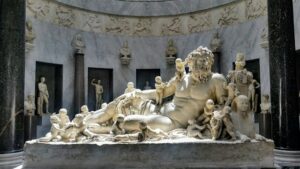Which Goddess Cursed Medusa
In the intricate tapestry of Greek mythology, few tales possess the charisma and enigmatic aura surrounding Medusa’s story. Known for her serpentine locks and the ability to turn gazers into stone, Medusa’s tale is shrouded in the mystery of her cursed existence. Yet, the origin of this curse has sparked emotional debates among scholars and enthusiasts alike.
Who, or what, was the force behind the curse that transformed Medusa into the legendary Gorgon? Unraveling this enigma leads us down a path where gods and mortals intertwine, where vengeance and fate collide. Join us as we uncover the compelling question: Which goddess cursed Medusa?
Who Was Medusa?
In the annals of Greek mythology, Medusa emerges as an enigmatic figure, characterized by her striking visage adorned with serpentine locks and a gaze that could turn the living to stone. Descriptions of her appearance often depict a monstrous yet captivating being shrouded in both fear and fascination.
Medusa was one of the three Gorgon sisters, born from the union of ancient sea deities Phorcys and Ceto. Among the Gorgons, she stood out with her unique ability to petrify anyone who met her gaze—a power bestowed upon her, or perhaps cursed, depending on the version of the myth.
Beyond the fearful exterior, her story unfolds with layers of tragedy and complexity. Understanding Medusa involves delving into her origins, her role in the Greek pantheon, and the circumstances that led to her infamous curse. Let’s explore this compelling figure’s multifaceted identity and significance within Greek mythology.
The Curse on Medusa
The curse that befell Medusa is a pivotal aspect of her mythological narrative, shrouded in varying interpretations and complexities. In the annals of Greek mythology, the tale of Medusa’s curse often revolves around a clash involving deities, mortal hubris, and divine retribution.
1. Origins of the Curse
One prevalent version of the story narrates how Medusa, once a stunning priestess in Athena’s temple, faced the ire of the goddess herself. In this rendition, Poseidon, the god of the sea, ravished Medusa within the sacred confines of Athena’s sanctuary, violating the sanctity of her temple. Enraged by this blasphemy, Athena, often depicted as a protector of purity and innocence, directed her wrath not at Poseidon but at Medusa. The goddess cursed her, transforming her beauty into a horrifying visage that turned onlookers into stone.
2. The Role of Divine Vengeance
Athena’s curse, in this version, is seen as a form of divine retribution, punishing Medusa for an act of desecration she was powerless to prevent. The tragedy lies in Medusa’s innocence; her fate is irrevocably altered by the actions of immortals. Some interpretations view Athena’s curse as a means of safeguarding her honor and punishing Medusa as a scapegoat for the transgression committed in her temple.
3. Interpretations and Moral Complexity
However, interpretations diverge on the moral implications of the curse. Was it a punishment, a warning, or an act of cruel whimsy by capricious gods? Some argue that Medusa’s transformation resulted from her victimhood, highlighting the injustices mortal women face in a world governed by divine whims.
4. Repercussions and Fate
The curse turned Medusa into a feared and tragic figure, ostracized and hunted due to her newfound monstrous form. Her fate became intertwined with heroism and tragedy as her story intersected with Perseus, leading to her demise by his hand, further solidifying her status as a victim of circumstance.
Medusa curse: Which goddess did it?

Among the pantheon of gods and goddesses, Athena is commonly associated with the curse that transformed Medusa into a Gorgon.
In one prevalent rendition, Medusa, a priestess serving in Athena’s temple, suffered a grievous violation when Poseidon, the god of the sea, defiled the sanctity of the temple by assaulting her. Outraged by this blasphemy, Athena’s response was directed not towards Poseidon but at Medusa herself. As a punishment, or perhaps as a means of safeguarding her temple’s sanctity, Athena cursed Medusa, altering her once beautiful visage into a horrifying countenance that petrified those who gazed upon her.
Did Athena curse Medusa to protect her?
The narrative suggests that Athena, as the goddess of wisdom, warfare, and protector of her sacred spaces, might have transformed Medusa to safeguard her temple’s sanctity.
According to this perspective, when Poseidon violated Athena’s temple by assaulting Medusa, the goddess redirected her wrath toward Medusa rather than the perpetrator. Athena’s actions are seen as an attempt to preserve the purity and sanctity of her sacred domain. By transforming Medusa into a terrifying figure whose gaze turned people to stone, Athena might have aimed to deter further trespasses and protect her temple from future desecration.
This interpretation implies that Athena’s curse, while seemingly harsh, was a measure taken to maintain the sacredness of her domain. It’s depicted as a form of divine intervention meant to defend the boundaries of her temple and uphold the reverence associated with her place of worship.
Conclusion
The enigmatic story of Medusa and the curse that transformed her into a Gorgon is a testament to the intricate and multifaceted nature of Greek mythology. Across various retellings, the question of which goddess cursed Medusa—often associated with Athena—unfolds within a tapestry of conflicting motives, divine justice, and moral complexity.
The myth presents Athena as a revered and questioned figure, embodying wisdom, courage, and the guardianship of sacred spaces. Her role in cursing Medusa sparks debates about divine intentions—was it an act of retribution, a safeguarding measure, or a complex interplay of both?
The narrative portraying Athena’s curse as a means to protect her temple highlights the complexities within ancient myths. It speaks of the blurred lines between divine justice and mortal repercussions, showcasing the intricate moral landscape of Greek mythology.


















